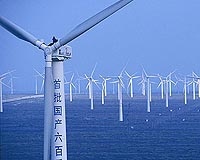 |
Bochum, Germany (SPX) Dec 02, 2010 The results achieved by this research team headed by Prof. Kurt Westerholt and Prof. Hartmut Zabel (Department of Physics and Astronomy at RUB) could contribute to new, power saving components in the future. The researchers reported on their findings in the American Physical Society's noted journal "The Physical Review". If it were possible to eliminate electrical resistance we could reduce our electric bill significantly and make a significant contribution to solving the energy problem, if it were not for a few other problems. Many metals as well as oxides demonstrate a superconductive state, however only at low temperatures. The superconductive effect results from Cooper pairs that migrate through the metal together "without resistance". The electrons in each Cooper pair are arranged so that their composite angular momentum is zero. Each electron has an angular momentum, the so-called spin, with a value of 1/2. When one electron spins counterclockwise (-1/2) and the other clockwise (+1/2), the total of the two spin values is zero. This effect, found only in superconductors, is called the singlet state.
Superconductive Cooper pairs Cooper pairs cannot continue to exist in a singlet state in a ferromagnetic material. Researches at RUB (Prof. Konstantin Efetov, Solid State Physics) among others have, however, theoretically predicted a new type of Cooper pair, which has a better chance of survival in ferromagnetic materials. In such Cooper pairs the electrons spin in parallel with one another so that they have a finite spin with a value of 1. Since this angular momentum can have three orientations in space, it is also known as the triplet state. "Obviously there can also be only one certain, small fraction of Cooper pairs in a triplet state, which then quickly revert to the singlet state" explained Prof. Kurt Westerholt. "The challenge was to verify these triplet Cooper pairs experimentally".
Tunnel current from Cooper pairs The central feature in these components consists of so-called tunnel barriers with a series of layers made up of a superconductor, insulator and another superconductor. Quantum mechanics allows a Cooper pair to be "tunneled" through a very thin insulating layer. Tunneling of a large number of Cooper pairs results in a tunnel current. "Naturally the barrier cannot be too thick, otherwise the tunnel current subsides. A thickness of one to two nanometers is ideal", according to Prof. Hermann Kohlstedt (CAU).
Double success in Bochum und Kiel "Triplet Cooper pairs can, however, be tunneled much better through such a ferromagnetic barrier", says Dirk Sprungmann, who was involved as Ph.D. student. If we are successful in converting a portion of the singlet Cooper pairs to triplet Cooper pairs, the tunnel current should be significantly stronger and be able to pass through a thicker ferromagnetic layer. This is precisely what the physicists in Bochum and Kiel tested. They allowed the Cooper pairs to pass through ferromagnetic barriers with thicknesses of up to 10 nanometers. With this attempt the physicists achieved a double success. On the one hand they were able to experimentally verify the existence of triplet Cooper pairs, and, on the other, they demonstrated that the tunnel current is greater than for singlet Cooper pairs in conventional tunnel contacts. "These new ferromagnetic tunnel barriers may possibly be used for new types of components", states Dr. Martin Weides (Santa Barbara). With their research findings the scientists confirmed, among other things, the theoretical work of a Norwegian research team published only a few weeks before. D. Sprungmann, K. Westerholt, H. Zabel, M. Weides, H. Kohlstedt: Evidence of triplet superconductivity in Josephson junctions with barriers of the ferromagnetic Heusler alloy Cu2MnAl. Physical Review B 82 (2010), DOI: 10.1103/PhysRevB.82.060505
Share This Article With Planet Earth
Related Links Ruhr-University Bochum Powering The World in the 21st Century at Energy-Daily.com
 China secures the lead in renewable energy
China secures the lead in renewable energyBeijing (UPI) Dec 1, 2010 China is now the leader in the global renewable energy market, a report by Ernst & Young says. The report, released Tuesday, comes a day after U.S. Energy Secretary Steven Chu, urging a push in American innovation in clean energy, warned that China's clean energy successes represent a new "Sputnik Moment" for the United States. "A new world is emerging in the clean energy sector ... read more |
|
| The content herein, unless otherwise known to be public domain, are Copyright 1995-2010 - SpaceDaily. AFP and UPI Wire Stories are copyright Agence France-Presse and United Press International. ESA Portal Reports are copyright European Space Agency. All NASA sourced material is public domain. Additional copyrights may apply in whole or part to other bona fide parties. Advertising does not imply endorsement,agreement or approval of any opinions, statements or information provided by SpaceDaily on any Web page published or hosted by SpaceDaily. Privacy Statement |